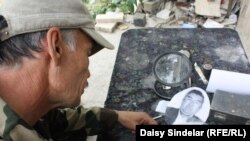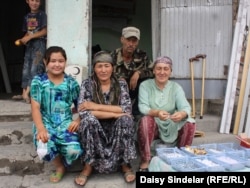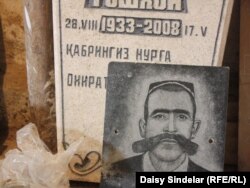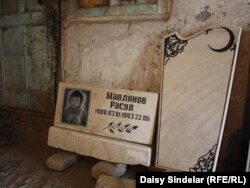OSH, Kyrgyzstan -- In the dry-goods market not far from the city center in Osh, you can find everything from Turkish fabric to plumbing supplies to plastic kitchenware from China.
You can also find Rashid, a 54-year-old Osh native who makes his living as a gravestone artist. Dressed in a striped military shirt and a camouflage jacket, he plies his trade inside a ramshackle, two-room shack near the market's eastern entrance, as his wife, 53-year-old Tursunoi, sits outside selling bolts, sink stoppers, and other small household items.
Rashid taps at an oval cut of black stone with a small metal pick, painstakingly chipping out a portrait of a broad-faced, middle-aged man in a dark pinstriped suit. The portrait will later be attached to a gravestone, already cut and engraved, waiting inside his small studio.
Follow our correspondent's tweets from Osh at @DaisySindelar
Rashid is famous for his likenesses, a popular feature on gravestones in this part of the world. A single portrait, which he is able to re-create starting with only a passport-size photo, can take him an entire day to complete and can cost as much as 950 soms, or $20.
"These big ones cost 4,000. Those that are even bigger cost 5,000," he says. "There are marble headstones. I even have black marble."
Altogether, a gravestone, complete with a hand-carved portrait, can cost more than $100 -- a fortune for many in Osh, where the global economic crisis and the fallout of last year's ethnic clashes have acted as a kind of devastating one-two punch on many family budgets.
Rashid, in fact, has seen his business drop since the clashes, in which 470 people died.
"People can't afford these anymore," he says, and gestures to the tombstone due to be matched to the portrait he is completing, of a man who died in 2008. "See? They put up temporary markers, metal ones, and when they can afford it, they come back to me for a real gravestone."
'I Do This For Everybody'
Rashid is Uzbek. But he says his clientele includes people from all of Osh's many ethnic groups -- Kyrgyz, Tatars, Russians, and others.
"A grave artist is like a doctor," he says, a doctor who doesn't turn anyone away.
"I do this for everybody -- Turks, Uzbeks, Tatars," he says. "I do every kind of gravestone. You can look and see for yourself; there are all kinds. Christian, national, European. I do everything."
Rashid learned his trade from his mother, Adolat, whose portrait graces the entrance to his studio. "She was an orphan and couldn't study at a proper school," he says. "But she was an artist in her blood. We all are."
All of Rashid’s six children are carrying on the tradition. Three of his adult sons have long since migrated to Russia, where they run their own gravestone-carving businesses. And his younger children help him in his studio, honing their own artistic skills.
"My youngest son is the best artist at his school," he says proudly, gesturing to a shy, 8-year-old boy peeking into the room from outside. "He steals my supplies when I’m not looking."
'Rashid Should Have Done It!'
Rashid's reputation as an artist and sculptor is widespread in this part of the world. He has delivered custom-made tombstones and even massive mausoleum-type structures as far away as Samarkand and Bukhara. Asked his opinion of the new statue unveiled in Osh last week to commemorate the one-year anniversary of the ethnic clashes, his wife jumps to his defense.
"I haven't seen it, but people say there's not much to it," says Tursunoi, whose first gift to Rashid during their courtship, a heavy book full of traditional Central Asian patterns and ornamental designs, still sits in his studio. "They say Rashid should have done it!"
Rashid, content to let his wife do the fighting, says he is a man of peace.
"Every time I'm angry about something, I just come here and do something with my hands," he says, showing off his hobby room where he keeps an eclectic collection of small sculptures and mold-cast pieces he creates in his spare time. There is a small metal statue of his favorite dog; a bare-breasted ceramic mermaid -- "I can't let the children see that one"; and even a rubber gorilla mask.
"Sometimes my wife gets a little mad," he says. "She says, 'It's night! It's time to come home!' But I like to stay here and just work on things like this."
But if work is Rashid's salvation, it is also, to some degree, his undoing. At 54, his face is tired and deeply lined, and though he is tall -- "my sons are 2 meters!" -- he is painfully thin, the result of a recent string of health problems and the lifelong stress of dealing with people at their moments of deepest grief.
"I remember every story behind every stone," he says, lighting a cigarette and gesturing to the gravestone, in for repairs, of a 5-year-old boy who drowned in a river. "I used to be so strong. But my time is over.
"I've had two heart attacks and three concussions, but I am still working as hard as I can. Every person who comes to me here -- whether they were affected by the clashes or not --- all the same they come to me and say, 'Oh, my child died,' or, 'My father died just like that; he wasn’t even sick.'
"And I'm putting their soul to rest: 'It's ok, please don’t be upset, we'll do everything for you. Don't cry. This happens to everyone. That's how life is.' And from all that, I have the face I have."
You can also find Rashid, a 54-year-old Osh native who makes his living as a gravestone artist. Dressed in a striped military shirt and a camouflage jacket, he plies his trade inside a ramshackle, two-room shack near the market's eastern entrance, as his wife, 53-year-old Tursunoi, sits outside selling bolts, sink stoppers, and other small household items.
Rashid taps at an oval cut of black stone with a small metal pick, painstakingly chipping out a portrait of a broad-faced, middle-aged man in a dark pinstriped suit. The portrait will later be attached to a gravestone, already cut and engraved, waiting inside his small studio.
Follow our correspondent's tweets from Osh at @DaisySindelar
Rashid is famous for his likenesses, a popular feature on gravestones in this part of the world. A single portrait, which he is able to re-create starting with only a passport-size photo, can take him an entire day to complete and can cost as much as 950 soms, or $20.
"These big ones cost 4,000. Those that are even bigger cost 5,000," he says. "There are marble headstones. I even have black marble."
Altogether, a gravestone, complete with a hand-carved portrait, can cost more than $100 -- a fortune for many in Osh, where the global economic crisis and the fallout of last year's ethnic clashes have acted as a kind of devastating one-two punch on many family budgets.
Rashid is pictured with his wife, Tursunoi (center), and other family members outside his studio in Osh.
Rashid, in fact, has seen his business drop since the clashes, in which 470 people died.
"People can't afford these anymore," he says, and gestures to the tombstone due to be matched to the portrait he is completing, of a man who died in 2008. "See? They put up temporary markers, metal ones, and when they can afford it, they come back to me for a real gravestone."
'I Do This For Everybody'
Rashid is Uzbek. But he says his clientele includes people from all of Osh's many ethnic groups -- Kyrgyz, Tatars, Russians, and others.
"A grave artist is like a doctor," he says, a doctor who doesn't turn anyone away.
"I do this for everybody -- Turks, Uzbeks, Tatars," he says. "I do every kind of gravestone. You can look and see for yourself; there are all kinds. Christian, national, European. I do everything."
Rashid learned his trade from his mother, Adolat, whose portrait graces the entrance to his studio. "She was an orphan and couldn't study at a proper school," he says. "But she was an artist in her blood. We all are."
All of Rashid’s six children are carrying on the tradition. Three of his adult sons have long since migrated to Russia, where they run their own gravestone-carving businesses. And his younger children help him in his studio, honing their own artistic skills.
"My youngest son is the best artist at his school," he says proudly, gesturing to a shy, 8-year-old boy peeking into the room from outside. "He steals my supplies when I’m not looking."
'Rashid Should Have Done It!'
Rashid's reputation as an artist and sculptor is widespread in this part of the world. He has delivered custom-made tombstones and even massive mausoleum-type structures as far away as Samarkand and Bukhara. Asked his opinion of the new statue unveiled in Osh last week to commemorate the one-year anniversary of the ethnic clashes, his wife jumps to his defense.
"I haven't seen it, but people say there's not much to it," says Tursunoi, whose first gift to Rashid during their courtship, a heavy book full of traditional Central Asian patterns and ornamental designs, still sits in his studio. "They say Rashid should have done it!"
Rashid, content to let his wife do the fighting, says he is a man of peace.
"Every time I'm angry about something, I just come here and do something with my hands," he says, showing off his hobby room where he keeps an eclectic collection of small sculptures and mold-cast pieces he creates in his spare time. There is a small metal statue of his favorite dog; a bare-breasted ceramic mermaid -- "I can't let the children see that one"; and even a rubber gorilla mask.
"Sometimes my wife gets a little mad," he says. "She says, 'It's night! It's time to come home!' But I like to stay here and just work on things like this."
But if work is Rashid's salvation, it is also, to some degree, his undoing. At 54, his face is tired and deeply lined, and though he is tall -- "my sons are 2 meters!" -- he is painfully thin, the result of a recent string of health problems and the lifelong stress of dealing with people at their moments of deepest grief.
"I remember every story behind every stone," he says, lighting a cigarette and gesturing to the gravestone, in for repairs, of a 5-year-old boy who drowned in a river. "I used to be so strong. But my time is over.
"I've had two heart attacks and three concussions, but I am still working as hard as I can. Every person who comes to me here -- whether they were affected by the clashes or not --- all the same they come to me and say, 'Oh, my child died,' or, 'My father died just like that; he wasn’t even sick.'
"And I'm putting their soul to rest: 'It's ok, please don’t be upset, we'll do everything for you. Don't cry. This happens to everyone. That's how life is.' And from all that, I have the face I have."



















